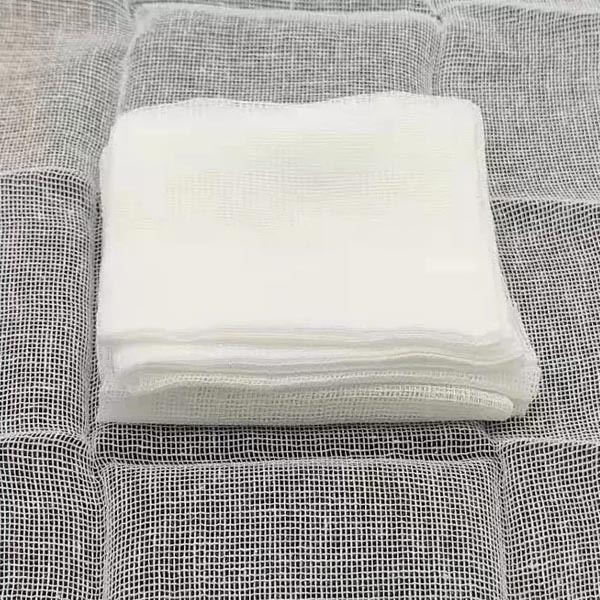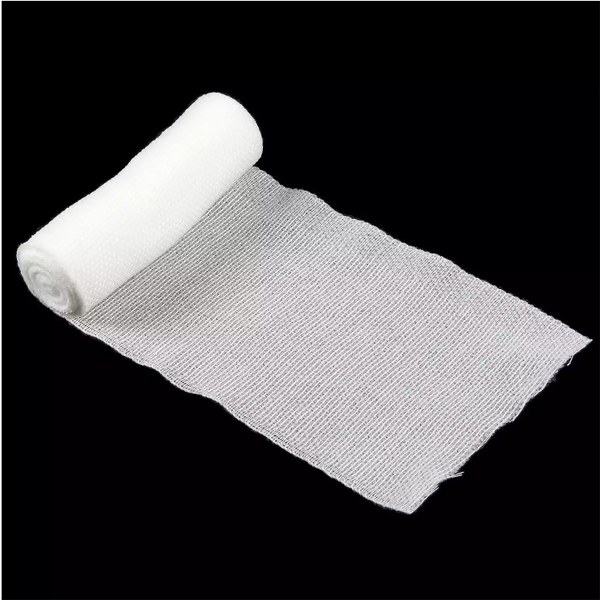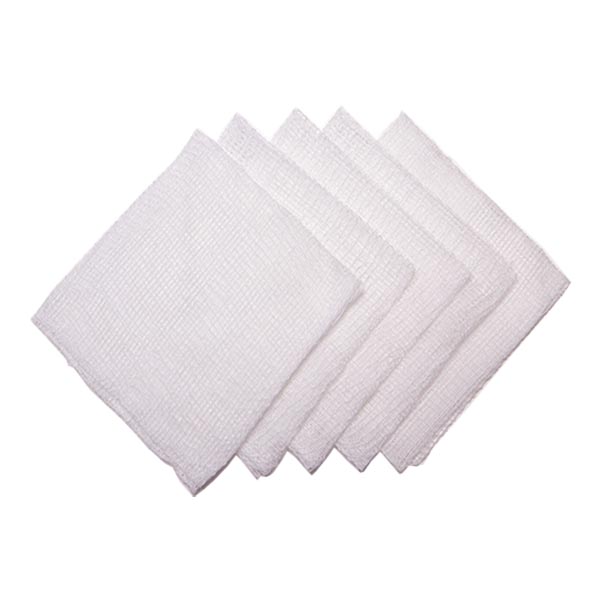This article provides a comprehensive comparison of gauze pads and gauze rolls, two essential staples in wound care. Whether you’re a healthcare professional like a hospital procurement manager or an individual managing first aid at home, understanding the specific uses and benefits of each type of medical gauze will empower you to make informed decisions for optimal wound healing. The article also features insights from a Chinese manufacturer, Allen, providing practical tips and information for global consumers.
1. What is Medical Gauze and Why is it Important?
Medical gauze is a thin, woven, or non-woven fabric that is used in wound care to cover and protect the wound. It’s an essential part of first aid and is widely used in medical settings for everything from minor cuts and abrasions to post-surgical care. The primary function of gauze is to absorb blood and other fluids (exudate) from the wound, creating a cleaner environment that promotes healing. The weave (or lack thereof in non-woven gauze) allows air to circulate to the wound, which is crucial for proper healing. Some gauze product options also provide a cushion to protect the wound from further trauma.
Using the correct type of gauze is important to prevent infection and promote faster healing. Gauze also helps to keep dressings in place. Choosing the wrong type of gauze can hinder the healing process or even cause complications. Different types of wounds require different types of gauze, so understanding the variations is critical. This is a product that can be a primary and secondary dressing.
2. Gauze Pads: The Versatile Choice for Wound Protection
Gauze pads are pre-cut, individual squares or rectangles of gauze. They are typically used as a primary dressing, meaning they are placed directly on the wound. Gauze pads are great because they are very convenient, easy to use, and come in a variety of sizes. This makes them suitable for many different types of wounds, from small cuts to larger abrasions.
Gauze pads are also very absorbent, which is important for managing drainage from the wound. They provide a soft cushion to protect the injured area. Some gauze pads are even impregnated with antimicrobial agents to further help prevent infection. Think of a gauze pad as the first line of defense, offering immediate protection and absorbency to a fresh injury. Because pads are convenient they are also a great fit to throw in a first aid kit.

3. What are the Main Types of Gauze Pads?
There are several different types of gauze pads available, each designed for specific needs. Here’s a breakdown of the main types:
-
Woven Gauze Pads: These are made from woven cotton fibers and have an open weave that allows for good airflow. Woven gauze pads are highly absorbent and are a good all-purpose option for many types of wounds.
-
Non-Woven Gauze Pads: These are made from synthetic fibers that are pressed together, rather than woven. Non-woven gauze is made to be stronger and less likely to leave lint in the wound than woven gauze.
-
Sterile Gauze Pads: These pads are individually packaged and sterilized, making them ideal for use on open wounds where the risk of infection is higher. Use sterile gauze whenever possible when dealing with broken skin.
-
Non-Sterile Gauze Pads: These are suitable for minor wounds that are not at high risk of infection, or for use as a secondary dressing to hold a primary dressing in place.
-
Gauze Sponges These are also called gauze sponges come is various shapes and sizes.
Choosing the right type of gauze pad depends on the type and severity of the wound.
4. Gauze Rolls: Securing Dressings and Providing Support
Gauze rolls, as the name suggests, are long, continuous strips of gauze that come in a roll. Unlike pre-cut pads, gauze rolls offer more flexibility in terms of size and application. They are primarily used to secure dressings in place, acting like a bandage. You can cut the roll to the desired length, making it adaptable to various wound sizes and body parts.
Gauze rolls can also be used to provide light compression to a wound, which can help to control bleeding. While gauze rolls can be used directly on a wound in some cases, they are more commonly used as a secondary dressing over a gauze pad or other wound dressing. Their flexibility makes it ideal for wrapping around limbs or other body parts where a flat pad might not conform well. Think of bandage rolls as the securing layer, keeping the primary dressing in place and providing additional support.
5. Woven vs. Non-Woven Gauze: What’s the Difference?
The distinction between woven and non-woven gauze lies in their construction and, consequently, their properties.
-
Woven Gauze: Gauze is made from fibers, typically cotton, that are interlaced in a crisscross pattern. This creates an open weave that allows for good airflow and absorbency. However, woven gauze tends to leave behind lint fibers in the wound, which can sometimes interfere with healing.
-
Non-Woven Gauze: This type of gauze is made from cotton and synthetic fiber (such as rayon or polyester) that are bonded together, creating a more compact and less linting material. Non-woven gauze is generally stronger and more absorbent than woven gauze, and it’s less likely to stick to the wound.
The choice between woven and non-woven gauze often comes down to the specific wound and personal preference. Non-woven gauze is often preferred for open wounds and surgical sites due to its lower linting properties.

6. Sterile vs. Non-Sterile Gauze: When Does it Matter?
The choice between sterile and non-sterile gauze is crucial for infection control.
-
Sterile Gauze: This gauze has been treated to eliminate all microorganisms, making it safe for use on open wounds, surgical sites, and other situations where the risk of infection is high. Sterile gauze pads are typically individually packaged to maintain their sterility. It’s critical to use sterile gauze on any wound that breaks the skin.
-
Non-Sterile Gauze: While clean, non-sterile gauze has not undergone the same sterilization process. It’s suitable for minor, closed wounds that are not at high risk of infection, or for use as a secondary dressing to hold a sterile dressing in place. Never apply non-sterile gauze directly to an open wound. It’s crucial to clarify that a non-sterile surface poses a significant risk of contamination.
7. How to Choose Between Gauze Pads and Gauze Rolls?
Choosing between gauze pads and gauze rolls depends primarily on the intended use:
-
Gauze Pads: Ideal for use as a primary dressing, placed directly on the wound to absorb fluids and provide protection. They are convenient for smaller wounds and are available in both sterile and non-sterile options. The pads are better suited for direct wound coverage.
-
Gauze Rolls: Use for wrapping and securing, to conform the shape.
-
Gauze Rolls: Best for securing dressings in place, providing support, and applying light compression. They are more versatile for wrapping around limbs or irregularly shaped body parts. Gauze rolls can also be used as a primary dressing in some situations, but gauze pads are generally preferred for direct wound contact.
In many cases, both gauze pads and gauze rolls are used together. The pad provides the initial absorbent dressing and protection, while the roll secures it in place. Think of it as a team: the pad does the direct work on the wound, and the roll provides the necessary support and coverage.
8. Choosing the Correct Gauze Size and Ply
Gauze pads and gauze rolls come in various sizes and "ply."
-
Size: The size you need depends on the size of the wound. For small cuts, a 2×2 inch gauze pad might be sufficient. For larger wounds, you might need a 4×4 inch pad or even larger. Gauze rolls come in various widths (e.g., 2 inches, 3 inches, 4 inches) and lengths, allowing you to cut the appropriate size for the dressing.
-
Ply: Ply refers to the number of layers of gauze in the pad or roll. A higher ply means a thicker, more absorbent gauze. Common ply counts include 8-ply, 12-ply, and 16-ply. For heavily draining wounds, a higher ply is recommended.
9. How Gauze is Manufactured in China: A Manufacturer’s Perspective
I’m Allen, and I work for ZhongXing, a medical device manufacturer in China with seven production lines. We specialize in producing high-quality medical gauze, cotton balls, and other disposable medical consumables. We export our products to the USA, North America, Europe, and Australia, serving hospitals, clinics, and medical distributors.
The manufacturing process for medical gauze involves several key steps:
- Raw Material Selection: We use high-quality, medical-grade cotton and synthetic fibers that meet international standards.
- Weaving/Non-Woven Production: Depending on the type of gauze, the fibers are either woven into a mesh pattern or bonded together using heat, pressure, or chemicals.
- Bleaching and Cleaning: The gauze is bleached to achieve a white color and thoroughly cleaned to remove any impurities.
- Cutting and Folding: The gauze is cut into the desired sizes for pads or rolled for gauze rolls. Gauze pads are pre-cut pieces while gauze rolls are long strips of material.
- Sterilization (if applicable): For sterile gauze, the product undergoes a sterilization process, typically using ethylene oxide gas or gamma irradiation.
- Packaging: The gauze is packaged in sterile or non-sterile packaging, depending on the product.
We adhere to strict quality control measures throughout the entire process, ensuring that our gauze products comply with ISO 13485, CE marking, and other relevant regulations. For a potential customer like Mark Thompson, a hospital procurement manager in the USA, this means he can be confident in the quality, safety, and regulatory compliance of our products. The main difference between gauze types from our factory comes down to these processes. We offer different weaves, sterilization methods, and packaging options to meet the diverse needs of our clients.

10. Beyond Gauze: A Look at ZhongXing’s (MedicalZX) Other Disposable Medical Products
While gauze is a core product, ZhongXing (MedicalZX) offers a wide range of other disposable medical consumables. This allows us to provide comprehensive solutions for our clients. These products, like our gauze, are manufactured to the highest quality standards and are designed for single-use to ensure hygiene and prevent cross-contamination. Our product range includes:
- Cotton Products: Medical Cotton, Cotton Balls, and Cotton Swabs for various medical applications.
- Dental: Dental Cotton Rolls for dental procedures.
- Nonwoven Disposables: Disposable Underlays/Dignity Sheets, Face Masks, Isolation Gowns, Medical Bed Sheets, Medical Bouffant Caps, Shoe Covers, and Surgical Gowns. These are crucial for infection control and maintaining a sterile environment.
- Respiratory Care: Nasal Oxygen Cannulas, Nebulizer Masks, and Oxygen Masks for patients requiring respiratory support.
- Surgery Supplies: Suction Connecting Tubes, Surgical Blades & Scalpels, Surgical Sutures with Needles, and Yankauer Handles for surgical procedures.
By offering a complete range of disposable medical supplies, we aim to be a one-stop shop for our clients, simplifying their procurement process and ensuring consistent quality across all their needs. This is especially valuable for procurement managers like Mark, who are responsible for sourcing a wide variety of products for their healthcare facilities.
Summary of Important Points
- Medical gauze is essential for wound care, providing absorption, protection, and promoting healing.
- Gauze pads are pre-cut and primarily used for wound coverage (primary dressing).
- Gauze rolls are used to secure dressings and provide support.
- Woven gauze is made from woven cotton fibers, while non-woven gauze is made from bonded synthetic fibers.
- Sterile gauze is essential for open wounds to prevent infection.
- Choosing the right size and ply of gauze depends on the wound’s size and drainage.
- Chinese manufacturers like ZhongXing (MedicalZX) produce high-quality medical gauze and other disposable medical supplies, adhering to international standards.
- Understanding the differences between gauze pads and gauze rolls is crucial for effective wound management.
- Gauze helps keep the area clear from bacteria.
- Gauze is a type of material commonly used in wound care.
- ZhongXing offers all forms of gauze pads and gauze rolls.
- If you have a serious wound, or if you have any questions, it is recommended to seek medical help. Always ask your healthcare provider what they recommend.
By understanding the differences between the various types of gauze, healthcare professionals and individuals can make informed decisions to provide optimal wound care. ZhongXing is committed to providing high-quality, reliable, and compliant disposable medical products to support effective healthcare practices worldwide.
Post time: 3月-10-2025





